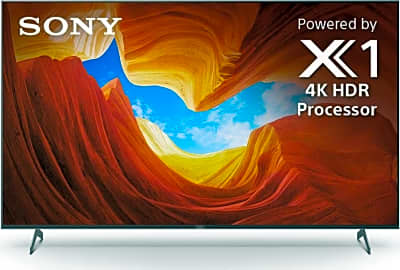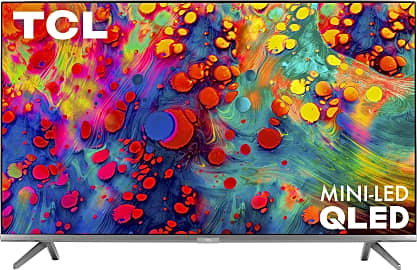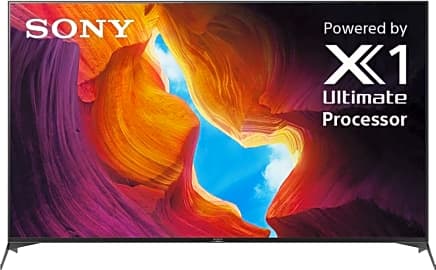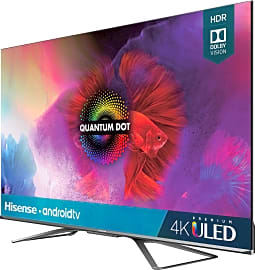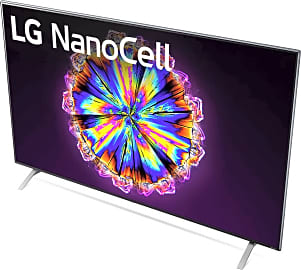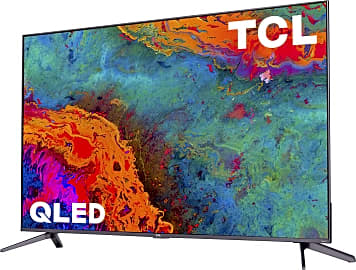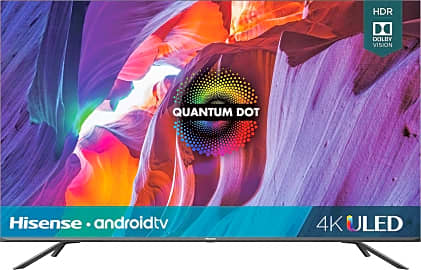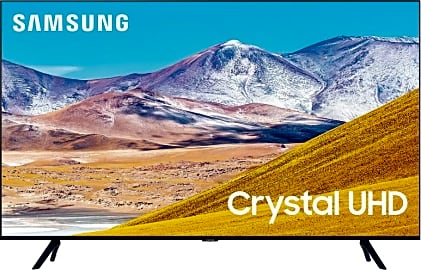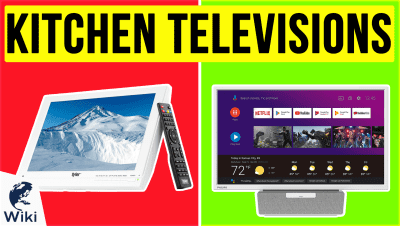The 10 Best Televisions

This wiki has been updated 40 times since it was first published in May of 2015. When it's time to upgrade your home entertainment system, check out one of these stunning and feature-rich televisions. These models let you enjoy movies, sports, games, and TV shows in glorious high definitions, with diverse smart capabilities for streaming online content. We've included a variety of offerings ranked by their size, resolution, user-friendliness, and color performance. When users buy our independently chosen editorial picks, we may earn commissions to help fund the Wiki.
Editor's Notes
November 24, 2020:
There are plenty of TVs to choose from, and, in fact, some would say there are too many to wade through without getting confused. Luckily what's available today is better than ever before, and there are a variety of advancements coming to budget and mid-range models that were exclusive to super-expensive models just a couple years ago.
Take, for example, the TCL S535, which has long been part of a highly cost-effective lineup. It, and its more expensive relative the TCL R635, both offer quantum dot filtration and local dimming, two things that used to unheard-of in TVs this reasonably priced. Similarly, we are impressed with the engineering from the up-and-coming manufacturer behind the Hisense H8G, which offers good performance on a moderate budget, and the Hisense H9G, which actually compares favorably to many big-name models. Of course, you don't really have to spend that much for something worthwhile, which is why we've highlighted the Samsung TU8000. It isn't fancy or particularly high-tech, but affords users an enjoyable cinematic experience and a decent or above-average time playing video games and watching sports.
If you're okay with making a sizeable investment, on the other hand, the LG CX is almost impossible to beat. Its premium OLED panel and top-of-the-line technical implementation can make it the last TV you have to buy for several years. The same can be said for the Samsung Q80T and Sony X950H, although the Sony unfortunately lacks support for 120-hertz video.
Speaking of Sony, the Sony X900H offers an impressive balance between cost and performance, as it actually does provide full HDMI 2.1 support, making it probably the best choice for owners of the PlayStation 5 or Xbox Series X. Also priced in the middle of the pack is the LG Nano90, which is a perfectly fine TV, but if you're at all concerned with HDR performance, you might want to look elsewhere.
November 24, 2020:
Our list this time around has had a complete overhaul with a bunch of new models coming out from the top companies in the sector. Notably, however, where previous lists have slowly eroded the presence of models with 1080 HD resolution, this is both the first ranking in this series to have no 1080 models and the first to include 8K offerings in the Samsung QLED Q950T, Sony Z8H, and LG NanoCell 99 Series. It would seem the era of the traditional HDTV is on its way out.
Now, it's important to note that the 8K models out there don't have OLED screens like you see on the Sony A8H or the LG GX Gallery Series, and this is where Samsung has actually set themselves up for success. While 8K OLED TVs would at this point be prohibitively expensive for all but the wealthiest consumers, Samsung has spent their time developing their QLED technology instead, giving them a leg up in color performance in the 8K sector. LG has their NanoCell tech, which achieves a good dynamic range and excellent local dimming, but can't match the Samsung for overall picture quality.
March 27, 2019:
Oh, 4K televisions, how you make us covet such high-priced technology. We'll be honest, we decided against including Samsung's Q900, which is the first commercially available 8K TV, because really, you don't need it. Not only is there almost zero 8K content available, we're not even sure that you could power an 8K-resolution display with a pair of liquid-cooled Geforce RTX 1080 Ti graphics cards. Maybe. But that whole rig would cost you somewhere around twenty grand.
On the other (and much more reasonable hand), TCL has a selection of TVs on the market that are exceptional values. If you're not trying to shell out a fortune on a home theater, they're the way to go. If you're willing to step up just a little in price, Vizio makes a QLED model that's incredibly well-priced. If you like bright colors and good prices, that's the one to choose. If you'll be gaming a lot and want to immerse yourself, look at Samsung's QLED line as well. Whatever the purpose, they produce some of the most realistic colors possible. But if you're going for cinematic quality, it's awfully hard to top LG, the current kings of OLED panels.
In fact, LG is, for the time bring and forseeable future, actually the only producer of OLED panels for the entire US market. Case in point, their "wallpaper TV" is finally readily available, and if you're a stickler for sleek form factors, you'll be delighted by its ultra-thin design. And of course we couldn't ever go without mentioning industry giant Sony, whose Master line of displays is quite worthy of the name. Plus, their X950G is both very, very attractive, as well as attractively priced -- which is something that can't usually be said for the Japanese behemoth's TVs. All in all, no matter how much you're trying to spend, it's a really, really good time to buy a TV.
Special Honors
Samsung 8K QLED Series There are a few of these available, and they are quite expensive, but they do represent some of the South Korean giant's best technology to date. Including variable 120-hertz refresh rates, quantum dot filtration, and powerful local dimming systems, these are premium TVs in every respect. samsung.com
LG WX If you're going for aesthetics as much as image quality, it's hard to beat the LG WX, more commonly known as the "wallpaper TV." The panel itself is only a few millimeters thick, and the controller is housed in a relatively small package kept nearby. It is pretty costly for its 65-inch form factor, but that's a small price to pay for the thinnest TV yet made. lg.com
LG ZX If you demand the best of the best and money is not an obstacle, this is almost certainly the choice for you. It comes in a 77- and a 88-inch version and is the only 8K OLED model currently available. There isn't actually much 8K content available yet, but with this high-end model, you'll certainly be ready for it if and when it arrives. lg.com
LEDing The Way
LEDs are preferred over other technologies for their longevity, low energy demand, and small size, allowing for the paper thin TVs we've all grown to love.
Even as resolution increases from 1080p to 4K and beyond (16K, anyone?, the fundamentals behind the actual illumination of pixels seem, for now, to be fixed in place.
This method of pixel illumination is what's commonly referred to as LED backlighting. It gets its name from the panel of Light Emitting Diodes at the back of the screen. LEDs are preferred over other technologies for their longevity, low energy demand, and small size, allowing for the paper thin TVs we've all grown to love.
Essentially, the information that becomes your screen image starts at the LED panel, where certain patterns of light resemble the most basic, binary analogue of your picture. Depending on whose technology you're using, this light gets filtered in slightly different ways, eventually making it through what I like to call the impressionist art phase and on to the Liquid Crystal Display that refines your final image.
As I mentioned a moment ago, our vision for the future of television production is as much to do with the size of the television as it is with its picture quality.
Most of the thinnest LED TVs hover around 2 inches, but OLED TVs, whose pixels illuminate themselves individually, eliminate the need for a back panel of diodes. That makes them, at least for now, the thinnest TVs around, and their superior picture quality is likely to have them replace today's LED technology once the market catches up.
And to be clear, OLED and 4K aren't mutually exclusive, but pairing up the technologies is currently very expensive.
How Big Is Big Enough?
Have you ever been late to a screening at an IMAX theater? I have. When Batman Begins first came out I went into New York City with some friends to see it at the IMAX at Lincoln Square. Our bus into the city moved at a crawl, the tunnel form New Jersey was packed, and we got into the theater just as the previews were ending.
Seating was limited, and I ended up in the front row, all the way on the right. Now, an IMAX screen is enormous, and here I was just 10, maybe 15 feet away from its bottom corner. My neck hurt for a week after that, and I still didn't even feel like I'd seen the movie.
My neck hurt for a week after that, and I still didn't even feel like I'd seen the movie.
The problem in this story is one of viewing distance. It's also one of real estate space in Manhattan and ticket greed among theater companies, but that's a different article.
Viewing distance is very simply the amount of space between you and your screen. If you've already got your space in place, and you know roughly where and how you'd like to sit in it, you can easily surmise what size television will give you the best experience.
In this case, as I hope the story above illustrates, bigger isn't always better. A TV too big for its room can leave you straining to take in the whole image.
A very crude rule of thumb for measuring your perfect TV by viewing distance for a 1080 HD screen is this: For every foot of space between your seat and your screen, you'll want about 10 inches of diagonal screen length. So, if your seat is four feet from your screen, you want a 40-inch TV. If you sit 10 feet away, you might go as high as 106 inches. However, as resolution increases, you'll either need a bigger screen or a shorter distance to appreciate it.
As you may already know, screens aren't measured on exact diagonals, but rather fall into a class based on their relative diagonal length. Couple that fact with the average American's state of vision health, and you can safely take that measurement and round up to the nearest class without feeling overwhelmed.
It's Not As Old As It Feels
It's hard to image it, but only 70 years ago there were less than 40,000 television sets in homes across the entire United States. There are single households in America today that have more than 40,000 Beanie Babies in them.
There's a lot of pressure to get it right, to buy the perfect TV set.
It's a technology that is, in its domestic form, less than 100 years old, and compared to other media for the transmission of art and ideas, its evolution hasn't even begun.
We can look back on those early TV designs, and on early FCC standards for resolution that gave way to NTSC broadcast standards, and it all seems so primitive.
I guess it helps to remember, when buying any piece of high technology, that we exist on a single point in its trajectory. There's a lot of pressure to get it right, to buy the perfect TV set. But you'd scoff just as easily at a black and white set from 1972 today as you will at today's sets in 40 years, if the concept of the "set" even exists then.
What I'm saying is, you can relax. All the TVs here have been vetted for you. They're all beasts, and you're going to love which ever one you choose.



